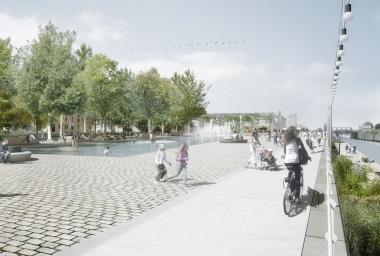
2015-02-06 – To turn the Canal Plan produced by Alexandre Chemetoff into concrete actions and projects, the Government of the Brussels-Capital Region took a number of important decisions on 5 February.
‘These measures,’ said the Minister-President, ‘are proof, if proof is needed, that the Government has prioritised the Canal Plan in its urban development strategy, in the firm belief that this area forms a sufficient basis on which to found the redeployment of Brussels over the next ten years.’
Identified potential
The definition of a plan for the Canal Area began in November 2012, when the brief for doing so was awarded to Alexandre Chemetoff in conjunction with Idea Consult and Ecorem.
The plan needed to:
- offer a response to the demographic boom and the associated need for new housing, schools, amenities and public spaces;
- challenge the deindustrialisation of this area and identify ways of regenerating economic activity that will create jobs for people in Brussels, using an approach that will also be sustainable in an inclusive urban context;
- ensure that the Canal Area links districts together rather than serving as a separating line between them.
One of the first achievements of the Canal Plan since its launch plan, according to the Minister-President, has been the mapping of the area and the identification of a Regional Estate: a network of public land of about 313 hectares, managed by the authorities, within which the Region must implement exemplary projects to serve as levers for the development of the entire area. ‘To respond to the challenges of Brussels, it is necessary, within the framework of the Canal Plan, to make optimal, responsible and effective use of public land through the systematic application, depending on the circumstances, of the principles of density, functional diversity and urban integration.’
Above all, stressed the Minister-President, ‘the design phase which has now been completed has made it possible to gauge the extent to which the Canal Plan’s subject – the potential of this area and the dynamism of its inhabitants, associations and businesses – can serve as the ingredients for a large-scale city-wide project that will unite all active forces in the Region to position Brussels among the European and world cities that will count in the future. No one still questions this strategy: although questions are sometimes raised, they tend to express impatience more than fears.
I welcome this new awareness and this desire that the Canal Plan has inspired in the city’s key players.’
The Canal Plan: an action strategy
The Canal Plan is now a concept, plan, and action strategy that covers the following:
- the identification of enormous potential – at least 25,000 homes and 7,500 jobs – illustrated by Alexandre Chemetoff at the test sites of Biestebroeck, Birmingham, Béco and Vergote;
- the identification of a public land network of more than 300 hectares, the Regional Estate, within which the Region and the authorities have a duty to set up exemplary projects;
- three fundamental principles at the basis of any project: density, functional and social mix, and urban integration;
- twelve test sites where this strategy will be applied;
- a location for a new economic dynamic, bringing businesses into the urban fabric and laying the foundations for the development of a modern, sustainable and inclusive urban economy.
‘The Canal Plan today is an extraordinary resource, shaped in the course of a design, development and persuasion phase, for which Alexander Chemetoff is to be commended,’ stressed the Minister-President.
12 million in ten years
This phase ends today, to be succeeded by the launch of an operational process to turn the Canal Plan into concrete reality. The Government has given itself ten years to implement this concept, plan and action strategy, based on a methodology approved on 5 February 2015.
The methodology is based primarily on the mobilisation of a budget of 12 million euros – an unprecedented sum for an urban development strategy in Brussels, and enough to put the ambitions for the Canal Area into action. This budget will be mobilised over ten years as an investment for the future.
In order to accelerate the formation of an urban development culture that prefigures a new way of ‘making the city’ in Brussels, the Government has decided to set up an internal team to implement the Canal Plan:
- at least three people will be taken on at Brussels Urban Development Authority (BUD), where they will be in charge of completing the work of and planning the test sites and a ‘research by design’ mission (involving rapid appraisal of sketches, development scenarios, and the feasibility and potential of a site, building or space, either as a basic proposal for a project or as a counter-project used to progress an initial project);
- two people will join the Urban Planning Department to speed up the processing of planning permission applications relating to the Canal Plan;
- finally, three people will serve as project leaders, in charge of the development of the test sites (and hence of the coordination of public and private projects; the optimal funding of public and/or mixed projects reflecting the principles of density, functional mix and urban integration on the basis of procedures to ensure the highest quality and exemplary character of public projects; and the provision of support to private developers in order to systematically advance projects in line with the Canal Plan objectives and enhance their architectural and urban quality).
Thus a team of at least eight people has been set up, with a budget until the end of the government’s term of office, and under the leadership of the recently appointed Chief Architect Kristiaan Borret.
Operational area
The Government has also decided to define an operational area which will prefigure an area of regional interest within the meaning of the Brussels Urban Planning Code (CoBAT).
This operational area of 700 hectares will be a frame of reference which:
- will form the action basis for a delegated official designated as special contact person for the processing of applications for planning permission related to the implementation of the Canal Plan;
- will serve as an area within which all large-scale projects should reflect the Canal Plan’s principles of development: density, functional mix and urban integration.
‘To be precise,’ noted the Minister-President, ‘the Government has decided to swiftly complete the formation of a specific structure dedicated to the operational implementation of the Canal Plan. Experience shows that urban development requires elements of both land control and project management. This will therefore be the purpose of this structure, which will be an offshoot of the SAF-MVV (‘Land Acquisition Company’ – ed.) as stipulated in the government agreement.’
Finally, it has also been decided that a substantial budget of approximately 7 million euros will be earmarked immediately to finance a large public space project on a test site, thus translating into concrete action the Government’s commitment to transform the Canal Area into a new central area linking different districts.
‘This future,’ concluded the Minister-President, ‘will rapidly take shape at sites such as Béco... While the images produced by Chemetoff should not be taken as gospel, they do illustrate a possible future that would enable 1,700 homes to be built, 700 jobs to be created and 100,000 square metres of parks and gardens to be developed. But beyond the answers that the Canal Plan must provide to the primary and legitimate needs of the people of Brussels in terms of housing, facilities and jobs, this area has the potential to move Brussels and the active organisations based in it towards a destiny as an attractive and inclusive European city, providing all urban actors with the means for development.’
More information here.
















